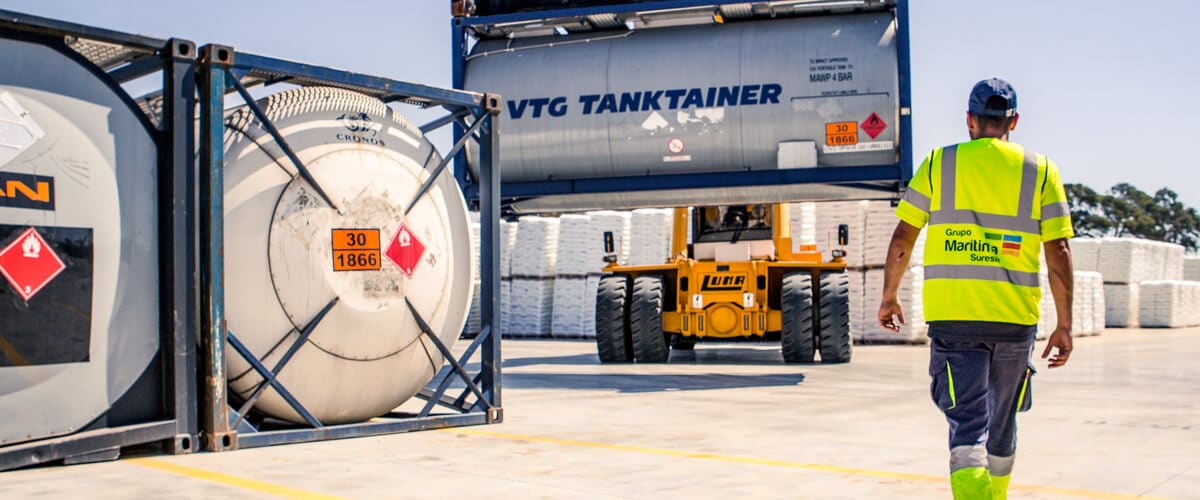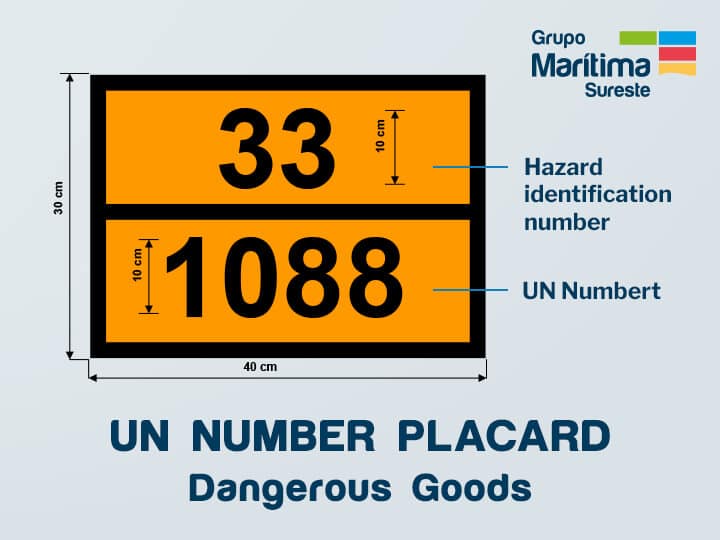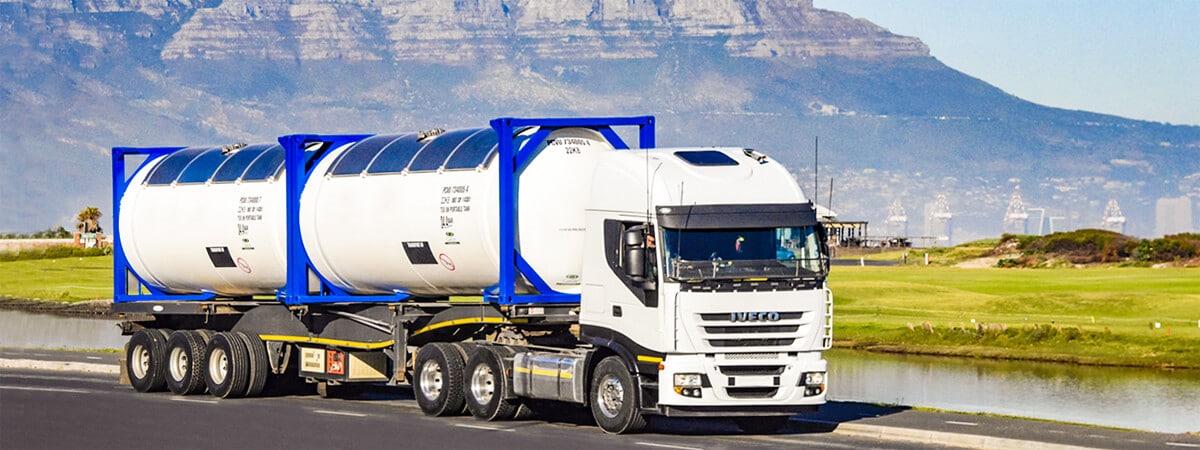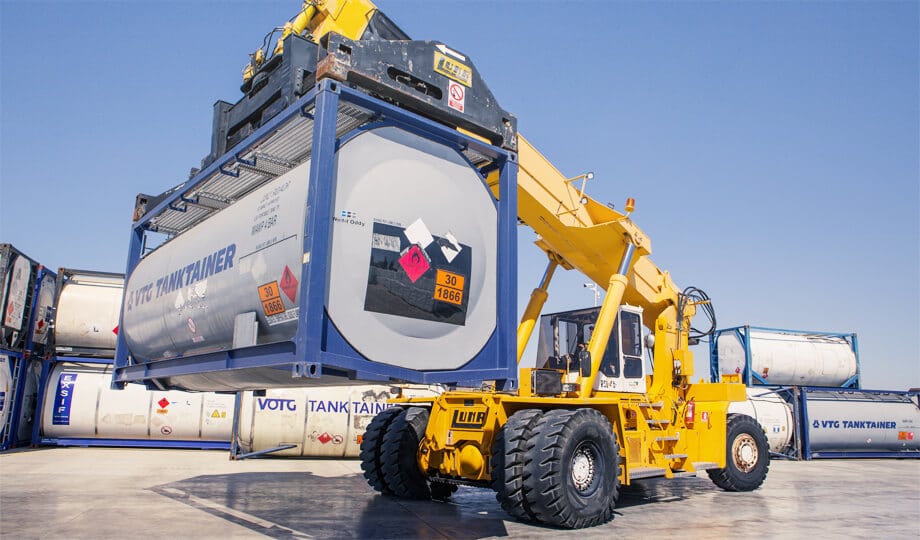Exporting and importing dangerous goods, safely and cost-effectively
When transporting dangerous goods by sea, the risks to the environment and people are multiplied.
Therefore, it is essential to comply with the IMDG regulations imposed by the IMO for this type of shipments by sea.
At Grupo Marítima Sureste we specialise in the transport, handling and storage of dangerous goods.
If you would like to consult our rates for logistics operations with hazardous substances or if you would like to request a quote for importing or exporting these goods, please call us.
Dangerous goods transport services by sea
To regulate the transport of dangerous goods by sea, the International Maritime Dangerous Goods Code (IMDG) was published in 1965 by the International Maritime Organization (IMO) to impose a set of mandatory rules regarding the transport of noxious, explosive, toxic or radioactive goods by maritime means.
When transporting dangerous goods, the container must be well packed, labelled and authorised in advance. If the cargo exceeds 4000 kg, the UN number must be indicated and an orange placard must be affixed indicating the commodity code.
Failure to comply with the regulations may result in severe penalties for endangering the welfare of the environment, the means of transport and people.
Table of contents

IMDG Code 2018: 39-18
The IMDG IMO Code sets out detailed recommendations for the carriage of substances, materials and articles considered as dangerous goods by sea.
It also sets out a number of suggestions for good operating practices.
In addition, information on terminology, packaging, labelling, stowage, segregation, handling and emergency action is included within the code.
Although the information in the IMDG Code is primarily aimed at shipping companies, the provisions can influence a large number of industries and businesses.
Port authorities will find reliable guidance on how to deal with emergencies involving dangerous goods.
Currently, in 2021, the 2018 edition of the IMDG Code, which includes amendment 39-18 and entered into force on 1 January 2020, is still in force.
The incorporation of the 2020 amendment 40-20 will not become mandatory until June 2022.
Handling and identification labels
In the event that you want to ship products classified as IMO dangerous goods, it is mandatory to affix either stickers or identification placards informing of the CLASS to which the goods carried in the sea container belong.
This identification card must be weather resistant so that neither the colours nor the symbols printed on it degrade.
There are two types of labels for marking dangerous goods. On the one hand, we have the risk labels, which are the ones we have seen in the previous section, and on the other hand, the handling labels.

Characteristics of dangerous goods placards
Dangerous goods placards accompanying dangerous goods during transport are square in shape with a side of at least 100 mm x 100 mm and rotated 45°.
The inner line parallel to the edges of the rhombus must be at least 2 mm thick and separated from the edge by at least 5 mm.
The symbol appears in the upper half and the class and subclass number in the lower half.
At Grupo Marítima Sureste we constantly carry out transport services of goods by sea, especially IMO dangerous goods. We have all the authorisations and we always use all the security measures imposed by law.
Do you need to export or import dangerous goods?
UN number
The other mark that must accompany dangerous goods during transport, in addition to the diamond indicating the class and its risk, is the orange UN number identification panel.
The UN number or UN code is a four-digit code ranging from 0004 to 3548 and indicates the risk of danger of the goods being transported.
These code numbers are assigned by the United Nations Committee of Experts on the Transport of Dangerous Goods and are listed in the Orange Book of “Recommendations on the Transport of Dangerous Goods”.
Depending on the type of chemical or its nature, some harmful materials share the same UN codification, as is the case of flammable liquids (UN1993).
On the other hand, there are substances that have their own UN number, such as acrylamide (UN 2074).
This UN code may vary even if it is the same chemical compound if it has different levels of concentration in solution, if it is in a stable form or if the risk or hazard is different depending on whether it is in solid, liquid or gaseous state.

IMO classification of goods
The International Maritime Organization, better known as IMO, classifies dangerous goods into 9 groups. By definition, these goods consist of goods and materials that pose a threat to the well-being of both people and the environment due to their characteristics.
Depending on their degree of harmfulness and specific characteristics, these goods are divided into 9 classes. The product safety data sheet provided by the manufacturer, also known as MSDS, indicates the class to which the product belongs.
It should be noted that the numbering imposed on the different classes has no direct relation to the magnitude of the risk or hazard potential they pose.
A CLASS 1 cargo according to IMO regulations is likely to be just as dangerous as radioactive materials belonging to CLASS 7.
To comply with the regulations, the container of dangerous goods must have an orange panel on its sides with the UN number and the distinctive mark of its class.
The materials included in each class are detailed below:
Class 1. Explosives
This class is made up of different types of articles based on their risk of detonation. Among this merchandise we can find pyrotechnics, flares, rockets, bombs, etc.
In addition to being identified by the orange background label with the UN number, the maritime container must have a square panel with an orange background, rotated 45 degrees with the silhouette of an exploding bomb and a number 1 must be located at the bottom.
Class 2. Gases
This class covers all types of gases, whether they are transported in liquefied, compressed or dissolved under pressure.
Depending on their properties they are classified as toxic, flammable or asphyxiating.
Depending on their main property, the square panel rotated 45° can have a red background with a flame, a white background with a skull or a green background with a bottle.
Class 3. Flammable liquids
This class includes all liquids which have the peculiarity of burning easily on contact with a heat source, such as paint, petrol, varnish or turpentine.
The diamond-shaped placard which must be clearly visible on the tank-container in which it is transported must have a red background, the symbol of a flame, black or white, and the number 3 at the bottom.
Class 4. Flammable solids
This is the turn for class 4, which covers solids which are easily ignited or which release gases when they come into contact with water. This class also covers self-reactive products and explosive goods.
The markings accompanying the goods travelling by sea must have a black flame and, depending on their reactive nature, a white and red background or a blue background.

Class 5. Organic oxidisers and peroxides
Liquids or solids which promote combustion or promote the development of fires through the combustion of other substances.
Organic peroxides are unstable substances which burn easily. They burn quickly and intensely.
Their IMO marking labels have a yellow background, or yellow and red, and have a flame at the top, either on a line or in a circle.
Class 6. Toxics
This class covers a variety of infectious and toxic substances. The former contain micro-organisms that cause all kinds of diseases, such as laboratory samples and cultures. The latter, toxic substances, are those that can cause death by inhalation, topical absorption or ingestion.
The panels identifying this class of dangerous goods have a white background, the number 6 at the bottom and either a skull or three crescent moons joined at their widest part in the centre.
Class 7. Radioactive material
Class 7 is reserved for chemically unstable materials with activity. This group includes uranium, plutonium and thorium, elements used in the nuclear industry.
In this case, the identification signs themselves include the word “radioactive” and the number 7 at the bottom. The background is soft and in some cases the upper half is yellow.
Class 8. Corrosives
Substances classified as number 8 according to IMO are goods that react on contact with other materials. These products can destroy skin, tissue and even disintegrate solids.
Examples of this type of goods are sodium hypochlorite or sulphuric acid.
The mandatory label for this IMO class has a black and white background, and has the image of two test tubes spilling fluids on a solid and a silhouette of a hand.
Class 9. Miscellaneous dangerous articles
This class covers all other articles and substances not covered by any of the previous 8 classes.
In this category can be found batteries and lithium batteries, dry ice and waste goods which are pollutants to the sea.
The identification for this class has a white background with black vertical stripes in its upper half and the 9 in its lower corner.


